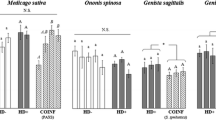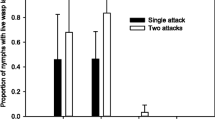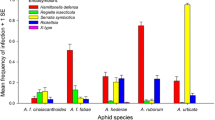Abstract
Mutualisms with facultative, non-essential heritable microorganisms influence the biology of many insects, and they can have major effects on insect host fitness in certain situations. One of the best-known examples is found in aphids where the facultative endosymbiotic bacterium Hamiltonella defensa confers protection against hymenopterous parasitoids. This symbiont is widely distributed in aphids and related insects, yet its defensive properties have only been tested in two aphid species. In a wild population of the grain aphid, Sitobion avenae, we identified several distinct strains of endosymbiotic bacteria, including Hamiltonella. The symbiont had no consistent effect on grain aphid fecundity, though we did find a significant interaction between aphid genotype by symbiont status. In contrast to findings in other aphid species, Hamiltonella did not reduce aphid susceptibility to two species of parasitoids (Aphidius ervi and Ephedrus plagiator), nor did it affect the fitness of wasps that successfully completed development. Despite this, experienced females of both parasitoid species preferentially oviposited into uninfected hosts when given a choice between genetically identical individuals with or without Hamiltonella. Thus, although Hamiltonella does not always increase resistance to parasitism, it may reduce the risk of parasitism in its aphid hosts by making them less attractive to searching parasitoids.




Similar content being viewed by others
References
Alkhedir H, Karlovsky P, Vidal S (2013) Relationship between water soluble carbohydrate content, aphid endosymbionts and clonal performance of Sitobion avenae on cocksfoot cultivars. PLoS One 8:e54327
Bensadia F, Boudreault S, Guay J-F, Michaud D, Cloutier C (2006) Aphid clonal resistance to a parasitoid fails under heat stress. J Insect Physiol 52:146–157
Brownlie JC, Johnson KN (2009) Symbiont-mediated protection in insect hosts. Trends Microbiol 17:348–354
Burke GR, Normark BB, Favret C, Moran NA (2009) Evolution and diversity of facultative symbionts from the aphid subfamily Lachninae. Appl Environ Microbiol 75:5328–5335
Castaneda LE, Sandrock C, Vorburger C (2010) Variation and covariation of life history traits in aphids are related to infection with the facultative bacterial endosymbiont Hamiltonella defensa. Biol J Linn Soc 100:237–247
Chen DQ, Montllor CB, Purcell AH (2000) Fitness effects of two facultative endosymbiotic bacteria on the pea aphid, Acyrthosiphon pisum, and the blue alfalfa aphid, A. kondoi. Entomol Exp Appl 95:315–323
Chen DQ, Purcell AH (1997) Occurrence and transmission of facultative endosymbionts in aphids. Curr Microbiol 34:220–225
Daza-Bustamante P, Fuentes-Contreras E, Niemeyer HM (2003) Acceptance and suitability of Acyrthosiphon pisum and Sitobion avenae as hosts of the aphid parasitoid Aphidius ervi (Hymenoptera : Braconidae). Eur J Entomol 100:49–53
Dedryver C-A, Le Ralec A, Fabre F (2010) The conflicting relationships between aphids and men: a review of aphid damage and control strategies. Comptes Rendus Biol 333:539–553
Degnan PH, Moran NA (2008a) Diverse phage-encoded toxins in a protective insect endosymbiont. Appl Environ Microbiol 74:6782–6791
Degnan PH, Moran NA (2008b) Evolutionary genetics of a defensive facultative symbiont of insects: exchange of toxin-encoding bacteriophage. Mol Ecol 17:916–929
Desneux N, Barta RJ, Hoelmer KA, Hopper KR, Heimpel GE (2009) Multifaceted determinants of host specificity in an aphid parasitoid. Oecologia 160:387–398
Dion E, Zele F, Simon JC, Outreman Y (2011) Rapid evolution of parasitoids when faced with the symbiont-mediated resistance of their hosts. J Evol Biol 24:741–750
Duron O et al (2008) The diversity of reproductive parasites among arthropods: Wolbachia do not walk alone. BMC Biol 6:12
Engelstadter J, Hurst GDD (2009) The ecology and evolution of microbes that manipulate host reproduction. Annu Rev Ecol Evol Syst 40:127–149
Feldhaar H (2011) Bacterial symbionts as mediators of ecologically important traits of insect hosts. Ecol Entomol 36:533–543
Feng MG, Johnson JB, Halbert SE (1991) Natural control of cereal aphids (Homoptera, Aphididae) by entomopathogenic fungi (Zygomycetes, Entomophthorales) and parasitoids (Hymenoptera, Braconidae and Encyrtidae) on irrigated spring wheat in southwestern Idaho. Environ Entomol 20:1699–1710
Ferrari J, Vavre F (2011) Bacterial symbionts in insects or the story of communities affecting communities. Philos Trans R Soc B Biol Sci 366:1389–1400
Ferrari J, West JA, Via S, Godfray HCJ (2012) Population genetic structure and secondary symbionts in host-associated populations of the pea aphid complex. Evolution 66:375–390
Foottit RG, Maw HEL, Von Dohlen CD, Hebert PDN (2008) Species identification of aphids (Insecta: Hemiptera: Aphididae) through DNA barcodes. Mol Ecol Resour 8:1189–1201
Fukatsu T, Tsuchida T, Nikoh N, Koga R (2001) Spiroplasma symbiont of the pea aphid, Acyrthosiphon pisum (Insecta : Homoptera). Appl Environ Microbiol 67:1284–1291
Guay JF, Boudreault S, Michaud D, Cloutier C (2009) Impact of environmental stress on aphid clonal resistance to parasitoids: role of Hamiltonella defensa bacterial symbiosis in association with a new facultative symbiont of the pea aphid. J Insect Physiol 55:919–926
Haine ER (2008) Symbiont-mediated protection. Proc R Soc B Biol Sci 275:353–361
Haynes S, et al. (2003) Diversity of bacteria associated with natural aphid populations. Appl Environ Microbiol 69:7216–7223
Henry LM, Ma BO, Roitberg BD (2009) Size-mediated adaptive foraging: a host-selection strategy for insect parasitoids. Oecologia 161:433–445
Henry LM, Roitberg BD, Gillespie DR (2006) Covariance of phenotypically plastic traits induces an adaptive shift in host selection behaviour. Proc R Soc B Biol Sci 273:2893–2899
Henry LM, Roitberg BD, Gillespie DR (2008) Host-range evolution in Aphidius parasitoids: fidelity, virulence and fitness trade-offs on an ancestral host. Evolution 62:689–699
Hilgenboecker K, Hammerstein P, Schlattmann P, Telschow A, Werren JH (2008) How many species are infected with Wolbachia?—A statistical analysis of current data. FEMS Microbiol Lett 281:215–220
Himler AG et al (2011) Rapid spread of a bacterial symbiont in an invasive whitefly is driven by fitness benefits and female bias. Science 332:254–256
Kavallieratos NG et al (2004) A survey of aphid parasitoids (Hymenoptera: Braconidae: Aphidiinae) of Southeastern Europe and their aphid-plant associations. Appl Entomol Zool 39:527–563
Kwak J et al (2006) Polyphasic assignment of a highly proteolytic bacterium isolated from a spider to Serratia proteamaculans. J Microbiol Biotechnol 16:1537–1543
Leonardo TE (2004) Removal of a specialization-associated symbiont does not affect aphid fitness. Ecol Lett 7:461–468
Leonardo TE, Mondor EB (2006) Symbiont modifies host life-history traits that affect gene flow. Proc R Soc B Biol Sci 273:1079–1084
Li S et al (2002) Pea aphid clonal resistance to the endophagous parasitoid Aphidius ervi. J Insect Physiol 48:971–980
Łukasik P, Hancock EL, Ferrari J, Godfray HCJ (2011) Grain aphid clones vary in frost resistance, but this trait is not influenced by facultative endosymbionts. Ecol Entomol 36:790–793
Łukasik P, van Asch M, Guo H, Ferrari J, Godfray HCJ (2013) Unrelated facultative endosymbionts protect aphids against a fungal pathogen. Ecology Lett 16:214–218
McLean AHC, van Asch M, Ferrari J, Godfray HCJ (2011) Effects of bacterial secondary symbionts on host plant use in pea aphids. Proc R Soc B Biol Sci 278:760–766
Montllor CB, Maxmen A, Purcell AH (2002) Facultative bacterial endosymbionts benefit pea aphids Acyrthosiphon pisum under heat stress. Ecol Entomol 27:189–195
Moran NA, Degnan PH, Santos SR, Dunbar HE, Ochman H (2005a) The players in a mutualistic symbiosis: insects, bacteria, viruses, and virulence genes. Proc Natl Acad Sci USA 102:16919–16926
Moran NA, McCutcheon JP, Nakabachi A (2008) Genomics and evolution of heritable bacterial symbionts. Annu Rev Genet 42:165–190
Moran NA, Russell JA, Koga R, Fukatsu T (2005b) Evolutionary relationships of three new species of Enterobacteriaceae living as symbionts of aphids and other insects. Appl Environ Microbiol 71:3302–3310
Muller CB, Adriaanse ICT, Belshaw R, Godfray HCJ (1999) The structure of an aphid-parasitoid community. J Anim Ecol 68:346–370
Nyabuga FN, Outreman Y, Simon JC, Heckel DG, Weisser WW (2010) Effects of pea aphid secondary endosymbionts on aphid resistance and development of the aphid parasitoid Aphidius ervi: a correlative study. Entomol Exp Appl 136:243–253
Oliver KM, Campos J, Moran NA, Hunter MS (2008) Population dynamics of defensive symbionts in aphids. Proc R Soc B Biol Sci 275:293–299
Oliver KM, Degnan PH, Burke GR, Moran NA (2010) Facultative symbionts in aphids and the horizontal transfer of ecologically important traits. Annu Rev Entomol 55:247–266
Oliver KM, Degnan PH, Hunter MS, Moran NA (2009) Bacteriophages encode factors required for protection in a symbiotic mutualism. Science 325:992–994
Oliver KM, Moran NA, Hunter MS (2005) Variation in resistance to parasitism in aphids is due to symbionts not host genotype. Proc Natl Acad Sci USA 102:12795–12800
Oliver KM, Noge K, Huang EM, Campos JM, Becerra JX, Hunter MS (2012) Parasitic wasp responses to symbiont-based defense in aphids. BMC Biol 10:11
Oliver KM, Russell JA, Moran NA, Hunter MS (2003) Facultative bacterial symbionts in aphids confer resistance to parasitic wasps. Proc Natl Acad Sci USA 100:1803–1807
Outreman Y, Le Ralec A, Plantegenest M, Chaubet B, Pierre JS (2001) Superparasitism limitation in an aphid parasitoid: cornicle secretion avoidance and host discrimination ability. J Insect Physiol 47:339–348
Powell W (1982) The identification of hymenopterous parasitoids attacking cereal aphids in Britain. Syst Entomol 7:465–473
R Development Core Team (2011) R: a language and environment for statistical computing. R Foundation for Statistical Computing, Vienna
Russell JA, Latorre A, Sabater-Muńoz B, Moya A, Moran NA (2003) Side-stepping secondary symbionts: widespread horizontal transfer across and beyond the Aphidoidea. Mol Ecol 12:1061–1075
Russell JA, Moran NA (2006) Costs and benefits of symbiont infection in aphids: variation among symbionts and across temperatures. Proc R Soc B Biol Sci 273:603–610
Russell JA et al (2013) Uncovering symbiont-driven genetic diversity across North American pea aphids. Mol Ecol (online early)
Sandstrom JP, Russell JA, White JP, Moran NA (2001) Independent origins and horizontal transfer of bacterial symbionts of aphids. Mol Ecol 10:217–228
Scarborough CL, Ferrari J, Godfray HCJ (2005) Aphid protected from pathogen by endosymbiont. Science 310:1781
Schmid M, Sieber R, Zimmermann Y-S, Vorburger C (2012) Development, specificity and sublethal effects of symbiont-conferred resistance to parasitoids in aphids. Funct Ecol 26:207–215
Schmidt MH, Lauer A, Purtauf T, Thies C, Schaefer M, Tscharntke T (2003) Relative importance of predators and parasitoids for cereal aphid control. Proc R Soc Lond Ser B Biol Sci 270:1905–1909
Sigsgaard L (2002) A survey of aphids and aphid parasitoids in cereal fields in Denmark, and the parasitoids’ role in biological control. J Appl Entomol Zeitschr Angew Entomol 126:101–107
Traugott M et al (2008) Endoparasitism in cereal aphids: molecular analysis of a whole parasitoid community. Mol Ecol 17:3928–3938
Tsuchida T, Koga R, Fukatsu T (2004) Host plant specialization governed by facultative symbiont. Science 303:1989
Tsuchida T et al (2010) Symbiotic bacterium modifies aphid body color. Science 330:1102–1104
Tsuchida T, Koga R, Shibao H, Matsumoto T, Fukatsu T (2002) Diversity and geographic distribution of secondary endosymbiotic bacteria in natural populations of the pea aphid, Acyrthosiphon pisum. Mol Ecol 11:2123–2135
Vorburger C, Gouskov A (2011) Only helpful when required: a longevity cost of harbouring defensive symbionts. J Evol Biol 24:1611–1617
Vorburger C, Sandrock C, Gouskov A, Castañeda LE, Ferrari J (2009) Genotypic variation and the role of defensive endosymbionts in an all-parthenogenetic host–parasitoid interaction. Evolution 63:1439–1450
Acknowledgments
P. Ł., J. F., H. C. J. G. designed the experiments. P. Ł., M. A. D. performed the experiments. P. Ł., J. F., H. C. J. G. analyzed the data and wrote the manuscript. We thank E. Frago, K. Oliver, J. Russell and K. Sullam for discussion and helpful comments on the manuscript. The work was supported by the UK Biotechnology and Biology Research Council award BB/E010857/1 and by a Sir Richard Southwood (Christensen Foundation) Graduate Scholarship to P. Ł.
Author information
Authors and Affiliations
Corresponding author
Additional information
Communicated by George Heimpel.
Electronic supplementary material
Below is the link to the electronic supplementary material.
Rights and permissions
About this article
Cite this article
Łukasik, P., Dawid, M.A., Ferrari, J. et al. The diversity and fitness effects of infection with facultative endosymbionts in the grain aphid, Sitobion avenae . Oecologia 173, 985–996 (2013). https://doi.org/10.1007/s00442-013-2660-5
Received:
Accepted:
Published:
Issue Date:
DOI: https://doi.org/10.1007/s00442-013-2660-5




